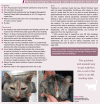Hepatic lipidosis: Clinical review drawn from collective effort
- PMID: 29478399
- PMCID: PMC10816292
- DOI: 10.1177/1098612X18758591
Hepatic lipidosis: Clinical review drawn from collective effort
Abstract
Practical relevance: Hepatic lipidosis (HL) is the most common form of liver dysfunction in cats. If recognized early and treated appropriately, the prognosis is good; if not, the prognosis is grave. Clinical challenges: Distinguishing HL as idiopathic or secondary is critical since the presence of a concurrent disease affects the therapeutic plan and the prognosis.
Audience: Despite the unique and severe nature of a cat's response to anorexia and the complexity of the metabolic changes underlying this condition, the clinical acumen and technical ability to effectively diagnose and treat HL are readily available to all small animal practitioners. Patient group: Although many species develop a 'fatty liver', the cat is one of relatively few species that suffer from HL. The classic presentation is that of an overweight cat that stops eating for days to weeks, losing weight in the process. Equipment: Abdominal ultrasound is frequently employed in the diagnostic work-up of an anorectic cat; ultrasonographic findings often support a presumptive diagnosis, provide samples for cytology and, perhaps most importantly, help identify concurrent conditions that must be addressed for therapeutic success. All of the equipment necessary for essential nutritional intervention in an anorectic cat is readily available and easily affordable. Evidence base: The material for this review draws heavily on a relatively large number of original studies, excellent reviews by recognized experts, and informative communication with experienced clinicians, hence the term 'collective effort'.
Conflict of interest statement
The author declared no potential conflicts of interest with respect to the research, authorship, and/or publication of this article.
Figures




















References
-
- MacDonald ML, Rogers QR, Morris JG. Nutrition of the domestic cat, a mammalian carnivore. Annu Rev Nutr 1984; 4: 521–562. - PubMed
-
- MacDonald ML, Anderson BC, Rogers QR, et al. . Essential fatty acid requirements of cats: pathology of essential fatty acid deficiency. Am J Vet Res 1984; 45: 1310–1317. - PubMed
-
- Mazaki-Tovi M, Abood SK, Segev G, et al. . Alterations in adipokines in feline hepatic lipidosis. J Vet Intern Med 2013; 27: 242–249. - PubMed
-
- Barsanti J, Jones BD, Spano J, et al. . Prolonged anorexia associated with hepatic lipidosis in 3 cats. Feline Pract 1977; May: 52–57.
Publication types
MeSH terms
LinkOut - more resources
Full Text Sources
Other Literature Sources
Miscellaneous

